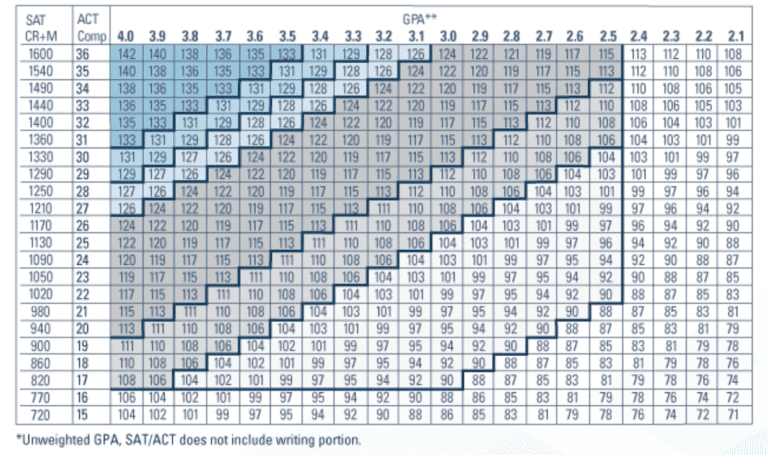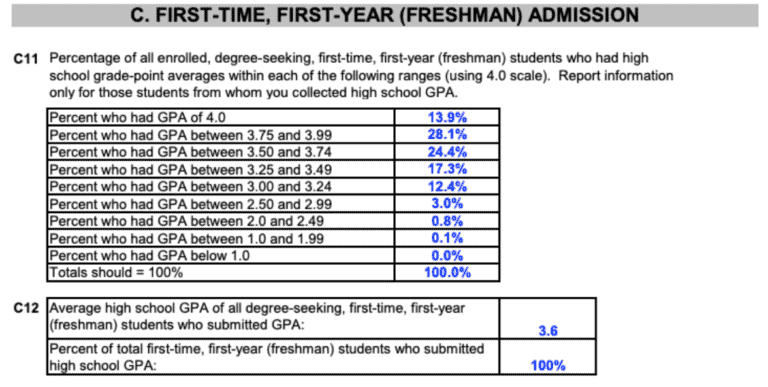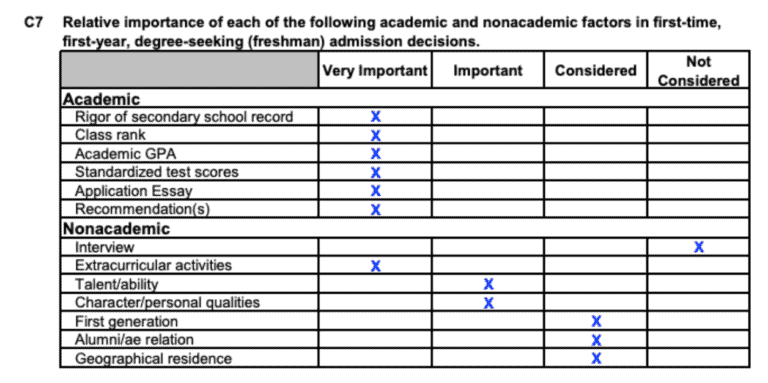
How Much Do Grades Matter in College Admissions?
You’ve probably heard it all your life: “You have to get good grades or you won’t get into a good college!” But when considering all the other factors – test scores, extracurricular activities, essays – how much do grades actually matter in college admissions? The answer: It depends on the school.

By NOELLE COMPTON
By now, you’ve probably heard a lot about how admissions officers use a holistic application process. In the age of test-optional, the message is stronger than ever: Colleges want to build a more diverse and inclusive cohort, attracting different students from the days of old. This means that colleges are actively seeking students from different backgrounds, but to what extent does this include academic performance, especially grades?
Academic Index and College Admissions
When an admissions officer first sees an application, one of the first things they look at is the “academic index”. In college admissions, the academic index refers to a student’s grades and SAT/ACT score. To an extent, a high test score can help balance a slightly lower GPA, and a high GPA can help to balance a slightly lower test score. Every college will have a way of calculating the academic index and determining a minimum threshold for candidates whose applications will be taken more seriously.
This is a little tricky to explain, so have a look at this example academic index:

In this sample, you can see test scores are on the Y-axis while GPA is on the X-axis. Each intersection of these items generates a value. In this illustration, the shaded values might represent different things. For example, the dark blue may represent automatic admits or merit-based financial aid recipients. Meanwhile, the lightest gray might represent waitlisted students.
The particular values in this illustration are not important, only the methodology. Colleges use an academic index to quickly sort through their vast volume of candidates to determine who they are most interested in. The higher the grades and test score, the more attractive the candidate, but the academic index, in general, will be treated as a baseline for admission. After this baseline is established, colleges will consider other factors such as activities, essays, etc.
How do I know if my grades are good enough for a particular college?
In general, colleges do not publish their academic indexes, but it’s still possible to see the range of grades they are looking for among prospective students. For this, we use an incredibly useful tool called the “Common Data Set”. The Common Data Set is an initiative to publish admissions data from different institutions in a way that is easy to read and interpret. The Common Data Set provides quantitative and qualitative metrics for admissions in an attempt to bring transparency to the admissions process.
You can look up the Common Data Set for a particular year for most schools. Here are the instructions for retrieving the report:
- Google “(Name of School) Common Data Set (Most recent admissions year) Ex. UMiami Common Data Set 2020-2021
- Find the result that belongs to the school’s official website – look for the .edu in the URL
Once you have the Common Data Set, go to section C-11, which provides reports on average grades for an admitted class. The report gives a breakdown of the percentage of admitted students. That report generally looks like this:

If the Common Data Set does not deliver these numbers, there are two other methods for determining a school’s GPA expectations.
First, you can simply Google “(Name of School) average GPA”. These results are generally taken from a college’s website, though be sure to pay attention to the source when this is not the case.
Second, you can use Naviance or whatever portal your high school uses to track college admissions. Naviance will show you data from students who went to your high school, including the grades of students who were admitted to certain schools. This is probably the most accurate way to determine what grades a college is looking for, since it stacks you up against your peers, rather than the whole student population.
College Admissions Services
Schedule a Free Consultation
Meet with a mentor one-on-one via video chat to talk about your son/daughter’s admissions plan. Afterwards, receive a no-obligation Customized College Roadmap (CCR) with advice on courses, extracurricular activities, standardized tests, and Admissions Angle strategy.
What if my grades are weighted?
Weighted grades were invented to account for the difficulty of your course load. After all, why should a student be punished for taking harder classes when that means they receive a lower grade? However, colleges regard course load as a separate metric from grades.
If we have another look at the Common Data Set (from a school chosen at random), this time looking at section C-7, here’s what we see:

In the first row, we see “rigor of secondary school record”. This means, “how much did you challenge yourself, given your resources?” Some high schools offer the complete catalog of nearly 40 AP courses. Some high schools only offer a handful of AP courses. If you take four out of 25 available AP courses, that says something about the rigor of your coursework than that of a student who took four out of an available four AP courses. In either case, colleges want to know how ambitious you were when selecting courses.
In the third row, we see academic GPA (Note: For most colleges, both rigor of secondary school record and GPA generally fall into the very important column). This shows us that the difficulty of your coursework is calculated as a separate metric from your GPA, and that these two data points work in tandem to inform the admissions officers’ decision.
So how does this relate to weighted grades? In short, weighted GPAs are oftentimes not used in the admissions process, and in fact, GPAs are oftentimes entirely recalculated in the admissions office. Colleges have their own systems and algorithms that re-categorize transcripts to calculate GPAs that are consistent among all students.
The bottom line? When looking at a school’s average GPA, it’s best to use the unweighted number.
What if my high school does not use the 4.0 grade scale?
Most colleges use a 4.0 grading scale to calculate GPA, even if your high school uses a 100 point or 5.0 scale. If your high school doesn’t use the 4.0 scale, you can use online tools to convert your grades so that you can see how you compare to the average admitted student. Our favorite tool is GPAcalculator.net – Just print a copy of your transcript and manually input the grades and credits, and this tool will recalculate your GPA.
In the admissions office, they will recalculate your GPA to suit their own standards, so you don’t need to do anything differently when your counselor submits your grades. The 4.0 scale and GPA calculator are suggested here for your purposes so that you can determine how competitive you are as an applicant.
What if my grades are lower than a college’s average GPA?
As I mentioned earlier, admissions offices use a holistic process to admit students. They want to know the whole story behind a student, and the different items they ask for will help to paint a complete picture. If your grades are slightly lower than what a college expects, on average, they may still admit you based on factors like high test scores, excellent essays, extracurricular activities, or circumstances. For example, your GPA might be lower due to a single bad semester when you had a major surgical procedure. This is relevant information for your application, and if this is the case, then an admissions officer might be willing to overlook that semester.
In general, if your grades are slightly lower than you want them to be, we recommend that you strive hard for a high SAT or ACT score, which can help to balance your academic index. You should also adjust your college list to reflect a reasonable range of schools from foundation to target to reach.
If your GPA is way lower than what a school is looking for (for example, applying to Stanford with a 3.3 when nearly 70% of their admitted class has a 4.0), we would urge you to consider how you are allocating your resources. If a college has no essays and a small application fee, then sure, it doesn’t hurt to apply. But if that school wants several essays and $100, your time and money would be better spent somewhere more reasonable. While the admissions process can feel lottery-like in some ways, it is important to remember that it is NOT a lottery. Having the best, shiniest essays can help tip the balance, but not enough to overcome significantly lower grades than the expected average.
How much do grades matter in college admissions?
Grades matter a lot in college admissions. Not all schools expect a perfect GPA, but most schools look at your grades before they look at any other aspect of your application. If your grades do not fall in line with a school’s averages, you will have to shine in other ways to make up for this deficit.










